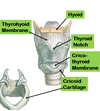Pharynx and Larynx Flashcards
1
Q
Pharynx Function
A
- Directs food into esophagus
- conducts air into Larynx and Trachea

2
Q
Three partsof Pharynx
A
- Nasopharynx
- Respiratory part of pharynx
- Oropharynx
- Laryngopharyx

3
Q
Ostium of the Auditory Tube (Pharyngotympanic/Eustacian Tube)
A
- connects middle ear to nasopharynx
- Torus Tubarius - carilagenous portion Pharyngotympanic tube that extends into nasopharynx

4
Q
Torus Tubarius
A
- Carilagenous portion of Pharyngotympanic Tube that extends into Nasopharynx

5
Q
Characteristics and Components of Oropharynx
A
- Palatoglossal arch seperates oropharynx from oral cavity
- Lingual Tonsil
- Palatine Tonsil
- Valleculae

6
Q
Origin of superior constrictor
A
- Pterygomandibular raphe
- common origin with buccinator muscle

7
Q
Piriform Recess (location)
A
- outpouching lateral to opening of larynx
- Foreign objects can get lodged here

8
Q
Tonsils are collections of what type of tissue?
A
- Lymphoid
9
Q
Types of Tonsils
A
-
Pharyngeal tonsils
- at roof of nasopharynx
-
Tubal tonsils
- ostium of auditory tube
-
Lingual tonsils
- Posterior 1/3 of tongue
- **Palatine tonsils **
- Between pillars of Glossopharyngeal Arches
- tonsillar fossa
10
Q
Tonsillectomies (removing which tonsil and risks)
A
- removing palatine tonsils
-
Risks
- highly vascularized –> excessive bleeding
- can damage glossopharyngeal nerve (lingual branch)
- would lead to altered sensation from posterior 1/3 tongue
11
Q
Tonsil Stones
A
- Calcified collections of cellular debris, bacteria, etc
- Can be cause of bad breath
- ***Only in people with intact palatine tonsils
12
Q
Adenoiditis
A
- enlarged/inflamed palatine tonsils
- breathing difficulty from blocked Chonae
- chronic blockage of auditory tube –> middle ear infections–> hearing loss
13
Q
Pharyngeal constrictors
A
- Superior
- Middle
- Inferior

14
Q
Pharyngeal Raphe
A
- Midline meeting of pharyngeal constrictors
- origin of pharyngeal constrictors

15
Q
A
















